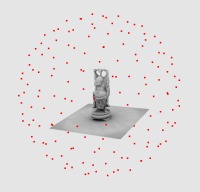Implementation
The above algorithm is the general description of the algorithm but not the
implementation that I chose to do. Instead, I chose to use the concept of
"Depth-Map Ambient Occlusion". The reason for using the depth-map based ambient
occlusion is that using hardware we are able to compute the ambient terms much
quicker than the ray tracing algorithm.
Depth-Map Based Ambient Occlusion
Depth-Map Ambient Occlusion approaches the problem
from a different perspective. It renders N viewpoints from outside the model and checks
to see which vertices are visible in the viewpoint, using a depth map, and then
computes the visibility contribution for that viewpoint for those vertices.
To generate viewpoints for this implementation, I chose to use a icosahedron, and
subdivided it until it reach the number of vertices that were desired for the
processing. This accounts for the strange number of viewpoints used for each of the
images above. The image below shows the viewpoints around the model.

From each of these viewpoints, the model was rendered into a depth map in the
graphics board memory then the depth map was read back into system memory. Each
vertex was projected into the depth map and its visibility was determined. If
it was visible, the cosine weighting was computed and added into the ambient occlusion
term.
Once all the views are computed, the model can be rendered with the ambient occlusion
term as its color information. Obviously this is not the final use for the term, it should
be used as part of the final equation for lighting the surface.
A bent normal can be computed to allow sampling environment maps to allow a nice complex
ambient effect. (A bent normal is just the normal along the direction where the surface
obtained most of its ambient light.)
No matter what the final
use, the model can be manipulated in real-time with this level of lighting information.
References
- Landis, Hayden - "Production Ready Global Illumination", Siggraph 2002
- Whitehurst, Andrew - "Depth Map Ambient Occlusion"
|